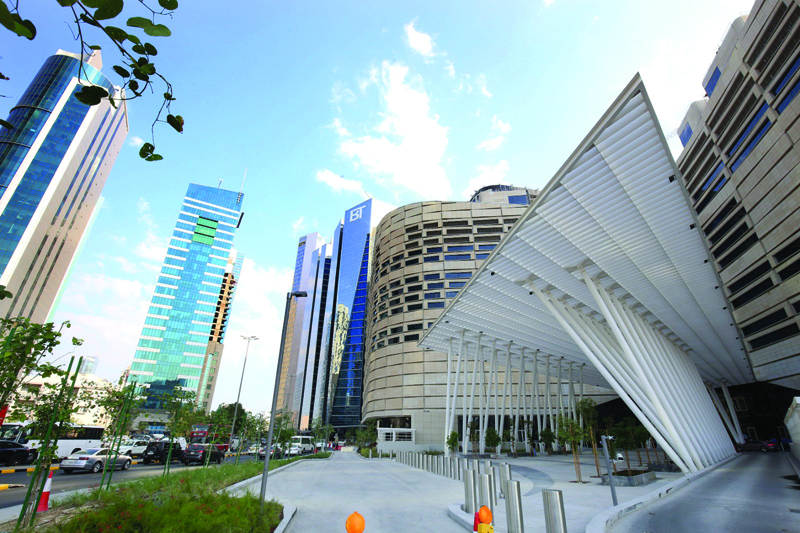 KUWAIT: The newly-inaugurated Assima Mall. Kuwait's real estate sales rose further in 3Q21, building on the full recovery seen in the first half of the year. - Photo by Yasser Al-Zayyat
KUWAIT: The newly-inaugurated Assima Mall. Kuwait's real estate sales rose further in 3Q21, building on the full recovery seen in the first half of the year. - Photo by Yasser Al-Zayyat
KUWAIT: Real estate sales rose further in 3Q21, building on the full recovery seen in the first half of the year. Sales in the quarter totaled KD1.1 billion (+16 percent q/q; +63 percent y/y), averaging a robust KD 360 million per month, on the back of strong activity in the residential sector and a significant increase in home and land prices. The third quarter also witnessed an improvement in commercial and investment (i.e. apartment) sector sales, although both remain below pre-pandemic levels and the investment sector remains challenged by weaker fundamentals (lower demand and higher vacancies).
Part of the reason for the divergence in performance between the residential and investment sector is a shift in investors' preference towards residential properties, which gained further momentum in 2017 after utilities tariffs on investment properties were increased. The coronavirus pandemic was also a factor, pressuring the incomes and employment of expatriates, who are major drivers of the apartment rental market. Looking ahead, residential activity should benefit from healthier demand and a still-limited supply of new units.
The proposed mortgage law, if passed, has the potential to boost the residential market, but should be accompanied by measures to prevent excessive price gains. Meanwhile, economic growth is returning and business activity is gradually recovering, which should be positive for both the commercial and investment sectors. Without a more significant shift in the preference of Kuwaitis for apartment rentals, the fortunes of the investment sector will likely remain linked to expatriate demand.
Residential sector activity
Residential sales reached KD 810 million in 3Q21 (+87 percent y/y), driven by a combination of higher volumes (+35 percent y/y) and a steep, general rise in land and home prices. The NBK residential home and land price indices were up by 27 percent y/y and 14 percent y/y, respectively, as of September. Solid fundamentals (limited supply and strong demand) continue to underpin gains in the residential sector, with demand partly driven by a young and growing population, in addition to increased investor interest due to stable returns: occupancy rates are higher than in the investment sector.
The divergence between the sectors is also due in part to several policy-related factors that have indirectly favored the residential sector. These include the exemption from higher utility tariffs since 2017, which has led to lower operating costs and thus stronger rental return margins in the residential sector and the absence of measures to curb price-raising and speculation, such as a second home tax or fees on long-standing vacant lots.
The above factors, coupled with the pre-existing weakness in the alternative apartment sector, continue to contribute to the significant residential price increases seen since 2018. Looking ahead, absent reforms and an increase in the supply of units, residential prices should remain elevated. Given the steep gains seen this year however, it would be surprising if prices continued to rise at recent rates and could even moderate somewhat ahead.
The residential market should receive a further boost from the likely approval by parliament of the government's draft mortgage law that was submitted last May. Legislation could come as early as 2022/23. This will facilitate financing and likely provide a further boost to residential activity and prices. However, of concern is affordability, with home prices increasing significantly in relation to the increase in the average citizen's income.
While the Public Authority for Housing Welfare has successfully planned and implemented, in partnership with the private sector, a number of large housing projects in recent years, the increase in the available stock of housing is insufficient to make a sizeable dent in the backlog of housing applications, estimated to be around 91,500 as of 2020 (this is before accounting for future demand). Therefore, the housing shortage will likely remain a challenge and require further initiatives in order to be resolved.
Investment sector
Investment sector (i.e. apartment) sales amounted to KD235 million in 3Q21 (+47 percent q/q; +70 percent y/y). This compares to a pre-pandemic quarterly average of KD279 million in 2019, reflecting a partial recovery. Higher sales were driven by a marked pick-up in volumes (+83 percent y/y), likely encouraged by lower prices (building prices were down 9 percent y/y) as the market adjusts to weaker demand and a decline in the expat population due to the pandemic.
This had added to pre-existing weaknesses in the sector-declining rents, lower prices, and rising vacancies-even before the pandemic due to oversupply and slower economic growth. We expect a full recovery to take some time given the gradual pace of the economic recovery and the government's efforts to promote Kuwaitization and address the demographic imbalance by proposing to cap the number of expats (bill proposed late 2020). Policy reforms aimed at curbing house purchases while promoting demand for apartments would help in restoring balance between the two sectors.
Commercial sector sales
Commercial sector sales in 3Q21 were a subdued KD 36 million (-60 percent y/y), which is still well below pre-pandemic levels. Volumes were down 40 percent y/y. As the economy and the business environment picks up, supported by progress on the vaccine front, a gradual recovery is expected for the sector. It may take some time, however, for the negative impact of the pandemic on SMEs, expatriate jobs and the labor market to subside and demand for commercial space to rebound.




